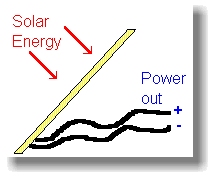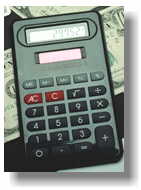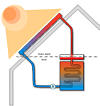![]()
![]()
![]()
![]()
![]()
![]()
![]()
![]()
![]()
![]()
![]()
This site is designed to be viewed on an
800 x 600 screen,
with level 4+ browsers.
Created by Andy Darvill,
Science teacher at
Broadoak Community School,
Weston-super-Mare, England
Web site www.darvill.clara.net
Introduction How it works More details Advantages Disadvantages Is it renewable?
![]()
Introduction
|
We've used the Sun for drying clothes and food for thousands of years, but only recently have we been able to use it for generating power. The Sun is 150 million kilometres away, and amazingly powerful. Just the tiny fraction of the Sun's energy that hits the Earth (around a hundredth of a millionth of a percent) is enough to meet all our power needs many times over. In fact, every minute, enough energy arrives at the Earth to meet our demands for a whole year - if only we could harness it properly. |
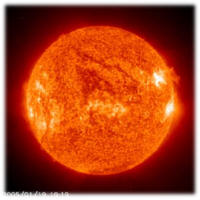 |
![]()
How it works
There are three main ways that we use the Sun's energy:-
|
1
Solar Cells (really called "photovoltaic" or "photoelectric" cells) that convert light directly into electricity. In a sunny climate, you can get enough power to run a 100W light bulb from just one square metre of solar panel.
|
|
|
|
|
|
2
Solar water heating, where heat from the Sun is used to heat water in glass panels on your roof. This means you don't need to use so much gas or electricity to heat your water at home. |
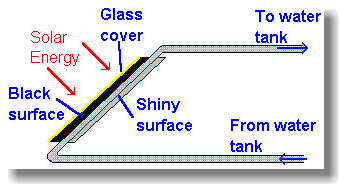 |
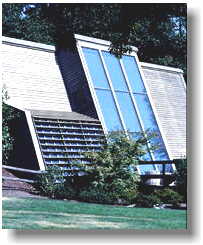 |
Water is pumped
through pipes in the panel. This helps out your central heating system, and cuts your fuel bills. However, in the UK you must remember to drain the water out to stop the panels freezing in the winter. Solar heating is worthwhile in places like California and Australia, where you get lots of sunshine.
|
|
3
Solar Furnaces use a huge array of mirrors to concentrate the Sun's energy into a small space and produce very high temperatures. There's one
at Odellio, in France, used for scientific experiments. |
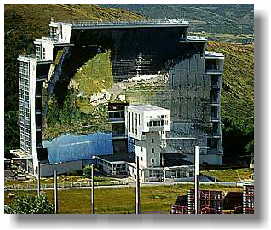 |
![]()
More details
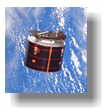 |
Solar cells provide the energy to run satellites that oribt the Earth. These give us satellite TV, telephones, navigation, weather forecasting, the internet and all manner of other facilities |
In California, the Solar One power station uses the Sun's heat to make steam, and drive a generator to make electricity. The station looks a little like the Odellio solar furnace , except that the mirrors are arranged in -circles around the "power tower". |
 |
As the Sun moves across the sky, the mirrors turn to keep the rays focussed on the tower, where oil is heated to 3,000 degress Celsius, The heat from the oil is used to generate steam, which then drives a turbine, which in turn drives a generator capable of providing 10kW of electrical power.
Solar One was very expensive to build, but as fossil fuels run out and become more expensive, solar power stations may become a better option.
![]()
Energex
(Australian power company): Animation of how a solar cell works at
www.energex.com.au/switched_on/activities/photovolatic/photovoltaic.html
| One idea that
is being considered is to build solar towers.
The
idea is very simple - you build a big greenhouse, which is warmed
by the Sun. In the middle of the greenhouse you put a very tall
tower. The hot air from the greenhouse will rise up this tower,
fast - and can drive turbines along the way. This could generate
significant amounts of power, especially in countries where there
is a lot of sunshine and a lot of room, such as Australia. |
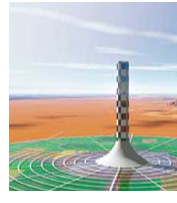 |
See also: www.fuelfromthesun.com
![]()
 Advantages
Advantages
- Solar energy
is free - it needs no fuel and produces no waste or pollution.
- In sunny countries,
solar power can be used where there is no easy way to get electricity
to a remote place.
- Handy for low-power
uses such as solar powered garden lights and battery chargers
Disadvantages
- Doesn't work
at night.
- Very expensive
to build solar power stations.
Solar cells cost a great deal compared to the amount of electricity they'll produce in their lifetime.
- Can be unreliable unless you're in a very sunny climate. In the United Kingdom, solar power isn't much use except for low-power applications, as you need a very large area of solar panels to get a decent amount of power.
![]()
Solar
power is renewable.
The Sun will keep on shining anyway, so it makes sense to use it.
![]()
|
|
|
Find out more, including grants towards installation, at www.cus.net Want to discuss
alternative energy issues? |
